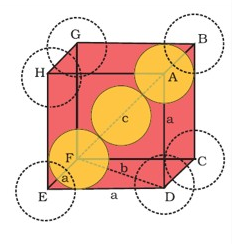12th Grade > Chemistry
SOLID STATE MCQs
Total Questions : 30
| Page 2 of 3 pages
Answer: Option B. -> ZnS
:
B
InZnSstructure, sulphide ions occupy allFCClattice points while Zn2+ions are present in alternate tetrahedral voids.
:
B
InZnSstructure, sulphide ions occupy allFCClattice points while Zn2+ions are present in alternate tetrahedral voids.
Answer: Option D. -> 12 part
:
D
In fcc, an atom at the center is shared by two unit cells.
So, it contributes 12to each of them.
:
D
In fcc, an atom at the center is shared by two unit cells.
So, it contributes 12to each of them.
Answer: Option B. -> Ferromagnetic
:
B
In solid state, the metal ions of ferromagnetic substances are grouped together into small regions calleddomains. Thus, each domain acts as a tiny magnet. In an unmagnetised piece of a ferromagnetic substance the domains are randomly oriented and their magnetic moments get cancelled. When the substance is placed in a magnetic field all the domains get oriented in the direction of the magnetic field and a strong magnetic effect is produced. This ordering of domains persist even when the magnetic field is removed and the ferromagnetic substance becomes a permanent magnet.
:
B
In solid state, the metal ions of ferromagnetic substances are grouped together into small regions calleddomains. Thus, each domain acts as a tiny magnet. In an unmagnetised piece of a ferromagnetic substance the domains are randomly oriented and their magnetic moments get cancelled. When the substance is placed in a magnetic field all the domains get oriented in the direction of the magnetic field and a strong magnetic effect is produced. This ordering of domains persist even when the magnetic field is removed and the ferromagnetic substance becomes a permanent magnet.
Answer: Option D. -> 26%
:
D
In face-centered cubic arrangement, 74% of the crystal space is filled
:
D
In face-centered cubic arrangement, 74% of the crystal space is filled
- Vacant space = 100 – 74 = 26%
Answer: Option B. -> Schottky
:
B
Due to presence of vacant lattice sites in Schottky defect, there is a decrease in the density of crystal.
:
B
Due to presence of vacant lattice sites in Schottky defect, there is a decrease in the density of crystal.
Answer: Option B. -> A,C
:
B
Amorphous solids consist of particles of irregular shape, so it displays short range order.
Amorphous solids soften over a range of temperature, and hence doesn’t show sharp melting point.
The value of a physical property will be same from any directions in case of amorphous solids. So, they are said to be isotropic in nature.
Amorphous solids do not have a definite heat of fusion.
:
B
Amorphous solids consist of particles of irregular shape, so it displays short range order.
Amorphous solids soften over a range of temperature, and hence doesn’t show sharp melting point.
The value of a physical property will be same from any directions in case of amorphous solids. So, they are said to be isotropic in nature.
Amorphous solids do not have a definite heat of fusion.
Answer: Option D. -> 2 and 4
:
D
The bcc cell consistes of 8 atoms at the corners and one atom at centre.
∴n=(8×18)+1=2.
The fcc cell consists of 8 atoms at the eight corners and one atom at each of the six faces.This atom at the faces is shared by two unit cells.
∴n=8×18+(6×12)=4
:
D
The bcc cell consistes of 8 atoms at the corners and one atom at centre.
∴n=(8×18)+1=2.
The fcc cell consists of 8 atoms at the eight corners and one atom at each of the six faces.This atom at the faces is shared by two unit cells.
∴n=8×18+(6×12)=4
Answer: Option C. -> Molybdenum (atomic mass = 95 g/mol)
:
C
The number of Argo atoms per unit cell(z) = 4
Density (d) = 10g/cm3
Edge length of unit cell (a) = 4000 nm = 4×10−8cm
We know that, d=z×Ma3×NA=>M=d×a3×NAz=10×(4×10−8)3×6.023×10234=96.368 g/mol
This value is closest to the atomic mass of molybdenum.
:
C
The number of Argo atoms per unit cell(z) = 4
Density (d) = 10g/cm3
Edge length of unit cell (a) = 4000 nm = 4×10−8cm
We know that, d=z×Ma3×NA=>M=d×a3×NAz=10×(4×10−8)3×6.023×10234=96.368 g/mol
This value is closest to the atomic mass of molybdenum.
Answer: Option B. -> In between 0.73 and 0.41
:
B
The structural arrangement of co-ordination number ‘6’ is octahedral and its radius ratio is 0.414 - 0.732.
:
B
The structural arrangement of co-ordination number ‘6’ is octahedral and its radius ratio is 0.414 - 0.732.

















